




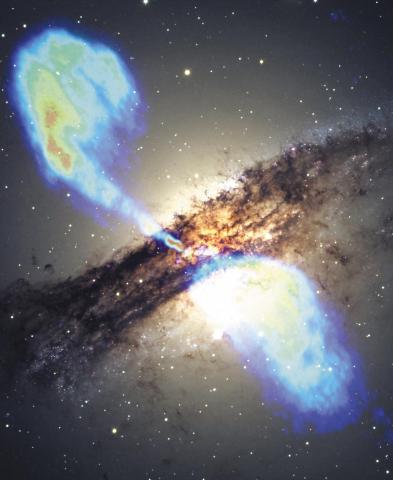
Astrophysics activities at Georgia Tech are devoted to interdisciplinary research and education linking astrophysics, astroparticle physics, cosmology, numerical relativity, and gravitational wave physics. Research focuses on extreme astrophysics such as mergers of black holes and neutron stars, central engines of active galactic nuclei, gamma ray bursts, and the sources of the highest energy neutrinos. Faculty that conduct astrophysics research at Georgia Tech form the Center for Relativistic Astrophysics (CRA).
- Astroparticle Physics: Georgia Tech's efforts in subatomic physics are in the area of experimental astroparticle physics. Astroparticle physics studies the most powerful objects in the Universe, such as pulsars, gamma ray bursts, supermassive black holes at the center of galaxies, and supernovas. Important questions that astroparticle physics helps to answer include the origin of cosmic rays, the acceleration of high-energy particles in astrophysical objects, tests of fundamental physics, the origin of dark matter, neutrino properties, etc. Our faculty, postdocs, and students collaborate in several large experiments to detect high-energy gamma rays and neutrinos, with activities ranging from data analysis to instrumentation. For more details, visit our website.
- Black Holes and Neutron Stars: Black holes and neutron stars are the most compact objects in the universe, where matter is packed to very high densities under the relentless force of gravity. They are ideal tools to study gravity at its most extreme as well as a variety of physical processes that often accompany them, such as accretion of gas and energetic interactions with their environment. At the CRA, we currently investigate several key open questions in this area of research.
- Computational Astrophysics: Dark matter, gravitational waves, black holes, neutron stars and neutrinos are just a few of the topics under consideration by the CRA faculty that require computational techniques. Computers allow us to solve complicated, coupled non-linear equations, track high-energy particles through the sky, and reproduce the Universe inside our virtual lab. The CRA uses the NSF XSEDE resources, the CRA cluster, Cygnus, and our Visualization Lab to explore some of the secrets of the Universe.
- Cosmology and Galaxy Evolution: The field of cosmology studies the universe in its entirety. The evolution of galaxies and their central black holes are particularly useful to understand both the relevant cosmological and galactic processes that shape galaxies over billions of years. The length scales involved in these processes can range from an atomic level, when studying atomic and molecular transitions that are important in star forming gas clouds, to the cosmological scale, where tidal forces from distant galaxies create the initial rotation of a galaxy.
- Exoplanets: Planets beyond our own Solar System. So far, thousands have been detected, and a large number of them show very different properties from those in our own Solar System. This challenges our classical understanding of planetary formation. At the CRA, we study the dynamical origin of planetary systems, which can explain many of the observed puzzles. In addition, we investigate the habitability of these planets based on their dynamical interaction in order to better understand the prevalence of life in the universe.
- Gravitational Physics: Gravity is one of the four fundamental interactions of nature. Yet some of the most interesting predictions of the theory that governs gravitational interactions, General Relativity, allude direct detection. Black Holes and Gravitational Waves are both results of General Relativity.
- High-Energy Astrophysics: High-energy astrophysics is the study of fundamental physics within the most violent environments imaginable. X-ray and gamma-ray sources are used as laboratories to explore physical processes at temperatures, densities, and energies so extreme that Earth-based experiments would be impossible. This type of research can therefore provide direct tests of many of the basic ideas of modern physics.
| Name | Research Interests | Research Website |
|---|---|---|
| David Ballantyne |
high-energy astrophysics; accretion disks; galaxy and black hole evolution My research concentrates on topics in high-energy astrophysics with an... |
Research/Teaching Website |
| Tamara Bogdanović | My research interests are in astrophysics of some of the most massive black holes in the universe, a.k.a., supermassive black holes. Within my group... | Research website |
| Laura Cadonati | I joined the Center for Relativistic Astrophysics at GeorgiaTech in January 2015, from the University of Massachusetts Amherst. My principal research... | Research Website |
| Gongjie Li |
Dynamics of Exoplanets; Interactions between supermassive black holes and surrounding stars |
Research Website |
| A. Nepomuk Otte |
Astroparticle Physics, Instrumentation, Photon detectors |
otte.gatech.edu |
| Feryal Özel | ||
| Dimitrios Psaltis | My research focuses on understanding the properties of black holes and testing the theory of general relativity across many astrophysical and... | Research Wedsite |
| Surabhi Sachdev | ||
| Eden Schapera |
Experimental astrophysics research and instrumentation development |
|
| Sven Simon |
Space plasma physics/theoretical physics Magnetospheres of the outer planets, large-scale magnetospheric dynamics Moon-magnetosphere interactions... |
GT Space Plasma Physics Group |
| Ignacio Taboada |
Neutrino Astrophysics with IceCube. We are currently witnessing the birth of a new branch of astrophysics: high-energy astrophysics. With neutrinos... |
Taboada's Research Page |
| John Wise | Computational astrophysics – Star and galaxy formation, Supernovae, Black hole evolution I study the intricacies of both the distant and nearby... | Computational Cosmology Group |
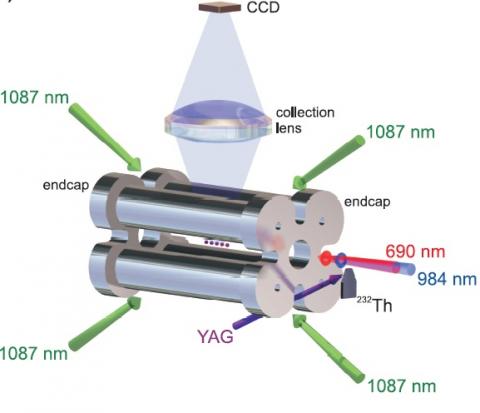
The Atomic, Molecular and Optical physics (AMO) group at Georgia Tech is a strong and diverse group that has made pioneering contributions in the areas of ultracold atomic physics, quantum degenerate gases, quantum optics, quantum information, ultrafast atomic physics, and ultrafast laser metrology.
In the last few decades, advances in laser technology and the invention of laser cooling and trapping techniques for atoms and molecules have opened entirely new, rapidly expanding frontiers of AMO science. These developments have been recognized by 4 recent Nobel prizes: laser-cooling and trapping (1997), Bose-Einstein condensations (2001), optical clocks (2005), and quantum control of ions and cavity QED (2012).
These advances and inventions have provided new tools for investigation of foundational questions in quantum mechanics, studies of atom-light interactions, “table-top” tests of fundamental physics and symmetries (including searches for electric dipole moments, g-2, etc.), and precision metrology of frequency, length, and other important physical quantities. In addition, these advances have led to new areas of research including the investigations of quantum degenerate gases, quantum information and computing, and ultrafast phenomena in atoms and molecules.
Technological applications that derive from work in atomic physics include precision sensors for inertial sensing and navigation, magnetic and electric field sensing, atomic clocks, and emerging quantum technologies — including quantum information processors and quantum communication networks.
Additionally, AMO science contributes to investigations in other areas of physics, including tests of general relativity, fundamental symmetries of the Standard Model, and many-body physics including condensed matter and nuclear physics. Ultra-cold atoms in particular provide new tools to construct quantum simulators to investigate important problems in condensed matter physics, including exotic magnetic order thought to arise in a wide variety of frustrated magnetic materials and unconventional superconductors.
Altogether, these advances have been truly transformative for the field of AMO science and have led to a significant expansion of AMO research programs world-wide. The Georgia Tech group has provided many impactful contributions to the field and enjoys a strong world-wide reputation.
| Name | Research Interests | Research Website |
|---|---|---|
| Michael Chapman |
Contemporary quantum mechanics, manipulating the quantum behavior of single atoms and photons |
Atom Trapping & Quantum Computing Laboratory Website |
| Brian Kennedy |
theoretical physics, quantum optics, atomic physics Recent research projects include investigations of the physics of quantum memories and quantum... |
|
| Colin V Parker |
Quantum simulation of strongly correlated electron systems using ultracold atoms. Atomic defects in solid state media. |
Parker Lab Homepage |
| Michael Pustilnik |
Transport and correlations in low-dimensional quantum systems |
|
| Chandra Raman |
Bose-Einstein condensation and quantum atomic sensors My group has two thrusts. In one effort we utilize sophisticated tools to cool atoms to... |
Raman Lab Webpage |
| Carlos Sa de Melo | Theoretical condensed matter and ultracold atomic and molecular physics: Superconductors, quantum magnets, superfluids and Bose-Einstein condensates... | |
| Rick Trebino |
The development of more powerful devices for manipulating and measuring potentially very complex light with ultrafast variations. Over 200... |
FROG |
| Xueda Wen |
My work focuses on theoretical physics. Specific research interests include: Non-equilibrium physics in quantum many-body systems... |
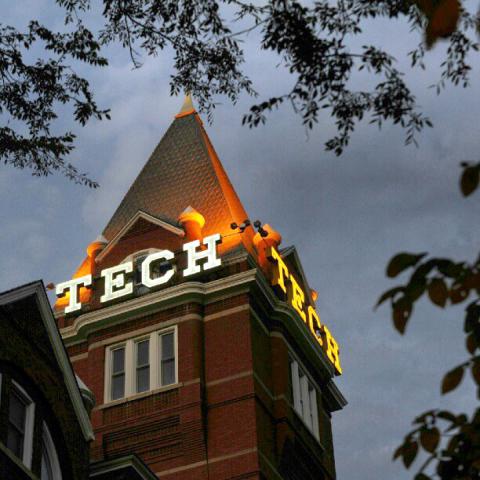
The Condensed Matter Physics (CMP) program is a critical component of research in the School. In terms of outside recognition, Ph.D. production, and research funding, the CMP group has played a major role in establishing the reputation of the School. It ranked No. 18 in the nation by U.S. News and World Report. The core strength of the CMP group has been in fabricating and understanding unique nanostructured materials, whereas in recent years, the strength has shifted to “quantum materials” such as new generation epitaxial graphene, topological insulators and semimetals, and quantum spin liquids. The CMP has and still actively collaborates with many units within the Institute, including Chemistry & Biochemistry, Materials Science and Engineering, Chemical & Biomolecular Engineering, and Electrical and Computer Engineering.
Dragomir Davidovic
Exploration of physical properties that emerge in objects when their size approaches nanometer-scale
Mesoscopic Physics & Low Temperature Physics...
Mesoscopic and Nano Physics Laboratory
Walter de Heer
NPEG: Nano Patterned Epitaxial Graphene, Nanoclusters in Beams
Epitaxial Graphene Lab
Chunhui Rita Du
Our research group focuses on developing quantum sensing and imaging technique to study various properties (spin, charge, and heat, etc) of quantum...
Du Quantum Sensing Lab
Glen Evenbly
My research is focused on the development of novel theoretical and numerical tools for modelling quantum many-body systems.
Tensor network...
Research Website
Phillip First
Developing an understanding of solid-state systems at atomic length scales
A primary goal of Professor First's research is to develop an...
Research Group Home Page
Zhigang Jiang
Quantum transport and infrared optical properties of condensed matter systems, including graphene, topological insulators, Dirac/Weyl semimetals, and...
Jiang Group Website
Itamar Kimchi
Theory of quantum matter:
We use analytics and numerics to study entanglement in real quantum materials and designer quantum systems.
Kimchi research group site
Uzi Landman
Surface and Materials Science, Solid State Physics, Nanoscience
Birth date: May, 1944 in Tel Aviv, Israel
Residence: USA
Citizenship: USA...
Martin Maldovan
Thermal Energy and Mass Transport at the Nanoscale Metamaterials Physics of Photonic and Phononic Materials
Research Group Website
Martin Mourigal
Condensed matter physics, quantum materials, frustrated and low-dimensional magnets, spin liquids, iron- and copper-based superconductors, magnetic...
Group Website
Colin V Parker
Quantum simulation of strongly correlated electron systems using ultracold atoms. Atomic defects in solid state media.
Parker Lab Homepage
Michael Pustilnik
Transport and correlations in low-dimensional quantum systems
Carlos Sa de Melo
Theoretical condensed matter and ultra-cold atomic and molecular physics: Superconductors, quantum magnets, superfluids and Bose-Einstein condensates...
Carlos Silva
The Silva group is interested in understanding how excited states are created and how they evolve in complex materials of interest in optoelectronics...
Silva Research Group Website
Synthesis of functional quantum materials
Spin transport and dynamics in quantum materials and devices
Spin qubit magnetometry
Hybrid quantum...
| Name | Research Interests | Research Website |
|---|---|---|
| Darcey Britton |
Computational Materials Science |
|
| Patrick Chen | ||
| Dragomir Davidovic |
Exploration of physical properties that emerge in objects when their size approaches nanometer-scale Mesoscopic Physics & Low Temperature Physics... |
Mesoscopic and Nano Physics Laboratory |
| Walter de Heer |
NPEG: Nano Patterned Epitaxial Graphene, Nanoclusters in Beams |
Epitaxial Graphene Lab |
| Chunhui Rita Du | Our research group focuses on developing quantum sensing and imaging technique to study various properties (spin, charge, and heat, etc) of quantum... | Du Quantum Sensing Lab |
| Jiyuan Fang |
My current research interest is Condensed Matter Theory. |
|
| Phillip First |
Developing an understanding of solid-state systems at atomic length scales A primary goal of Professor First's research is to develop an... |
Research Group Home Page |
| Zhigang Jiang | Quantum transport and infrared optical properties of condensed matter systems, including graphene, topological insulators, Dirac/Weyl semimetals,... | Jiang Group Website |
| Itamar Kimchi |
Theory of quantum matter: We use analytics and numerics to study entanglement in real quantum materials and designer quantum systems. |
Kimchi research group site |
| Uzi Landman |
Surface and Materials Science, Solid State Physics, Nanoscience Birth date: May, 1944 in Tel Aviv, Israel Residence: USA Citizenship: USA... |
|
| Chen-Shen Lee | ||
| Zhengyan Lin |
Research interest: condensed matter physics |
|
| Zhu-Xi Luo |
I mainly work on condensed matter theory but am also interested in its intersections with quantum information and high energy theory. |
|
| Martin Maldovan |
Thermal Energy and Mass Transport at the Nanoscale Metamaterials Physics of Photonic and Phononic Materials |
Research Group Website |
| Martin Mourigal | Our research group is focused on studying collective electronic and magnetic phenomena in quantum materials. Searching for new physics and a deeper... | Research Group Webpage |
| Colin V Parker |
Quantum simulation of strongly correlated electron systems using ultracold atoms. Atomic defects in solid state media. |
Parker Lab Homepage |
| Michael Pustilnik |
Transport and correlations in low-dimensional quantum systems |
|
| Carlos Sa de Melo | Theoretical condensed matter and ultracold atomic and molecular physics: Superconductors, quantum magnets, superfluids and Bose-Einstein condensates... | |
| Roshan S Trivedi |
Interested in pursuing Experimental Condensed Matter Physics |
|
| Samuel Turner |
Experimental Condensed Matter Physics |
|
| Chuanxin Wang | ||
| Hailong Wang |
Synthesis of functional quantum materials Spin transport and dynamics in quantum materials and devices Spin qubit magnetometry Hybrid quantum... |
Wang lab website |
| Xueda Wen |
My work focuses on theoretical physics. Specific research interests include: Non-equilibrium physics in quantum many-body systems... |
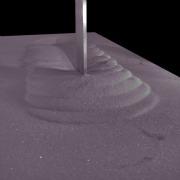
The beauty and complexity of the world around us owe a lot to the fact that the governing laws are nonlinear. This hidden commonality allows one to discover similarities in problems ranging from quantum phenomena at one end of the scale to the structure of the Universe at the other. Georgia Tech nonlinear dynamics faculty work on a correspondingly wide range of problems, from quantum systems, the dynamics of fluids and granular media, optical and electronic systems, to problems lying at the interface between physics, chemistry, biology, and medicine. For more information see the Center for Nonlinear Science website.
| Name | Research Interests | Research Website |
|---|---|---|
| Predrag Cvitanović | [former students] --- [open... | Personal homepage |
| Flavio Fenton | My work is on excitable media, complex systems, and pattern formation, using a combined approach of theory, experiments, and computer simulations.... | Lab Website |
| Daniel Goldman |
The dynamics of individual and collectives of of organisms and robots on and within complex materials. Goldman's research program broadly... |
Goldman Lab Website (contains up-to-date info on publications, news, CV, etc) |
| Edwin Greco |
Physics Education Research, Low Reynold's Number Flow, and Nonlinear Dynamics |
Physics Education Research |
| Roman Grigoriev |
Professor Grigoriev's research is focused in the following areas: Dynamical systems Fluid dynamics Excitable systems Machine learning Control More... |
Group Website |
| Michael Schatz |
Low-gravity fluid physics One of the most striking and beautiful behaviorsin the world around us is the way systems in nature take their shape.This... |
Pattern Formation & Control Laboratory |
| Atharv Tambade |
Nonlinear Dynamics, Machine Learning |
|
| Kurt Wiesenfeld |
Stochastic resonance, spontaneous synchronization , dynamical beam-steering in very high frequency antenna arrays |
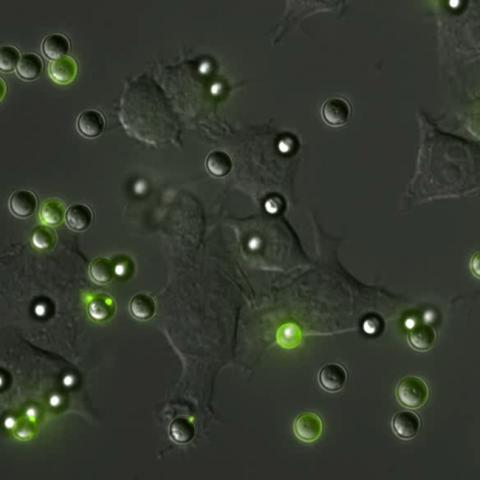
The Physics of Living Systems Group in the School of Physics at Georgia Tech seeks to understand how physics can inform questions of structure, function, and dynamics in biological systems, and to study fundamental physics questions posed by biological systems. Faculty associated with the group work on problems in a range of biological length and time scales: from evolution of planetary ecosystems over hundreds of millions of years to locomotion of 10 cm long lizards running on sand at 1 m/sec, to the mechanics of ~20 micron diameter cells and their dynamics on second to minute time scales, to assembly of viruses within 100 msec to the study of how DNA packing influences transcriptional dynamics and activity at the molecular level.
| Name | Research Interests | Research Website |
|---|---|---|
| Patrick Chen | ||
| Jennifer Curtis | Cell biophysics. Cell mechanics of adhesion, migration and dynamics. Immunophysics and immunoengineering. Hyaluronan glycobiology. Hyaluronan... | Curtis Lab Website |
| Flavio Fenton | My work is on excitable media, complex systems, and pattern formation, using a combined approach of theory, experiments, and computer simulations.... | Lab Website |
| Daniel Goldman |
The dynamics of individual and collectives of of organisms and robots on and within complex materials. Goldman's research program broadly... |
Goldman Lab Website (contains up-to-date info on publications, news, CV, etc) |
| JC Gumbart |
Computational simulations of complex biophysical phenomena involving proteins and other biomolecules |
Gumbart Lab Website |
| Harold Kim |
Single-molecule and single-cell studies of genome architecture. |
Harold Kim Lab |
| Simon Sponberg |
Neuromechancis, Locomotor Control, Multiscale Physics of Muscle, Maneuverability, Computational Neuroscience For publications please refer to the... |
Sponberg Lab Website |
| Peter Yunker | Nonequilibrium systems, densely packed active matter with life and death events, microbial physics, structural mechanics, fracture mechanics,... | Yunker Lab - Soft Matter of Life and Death |
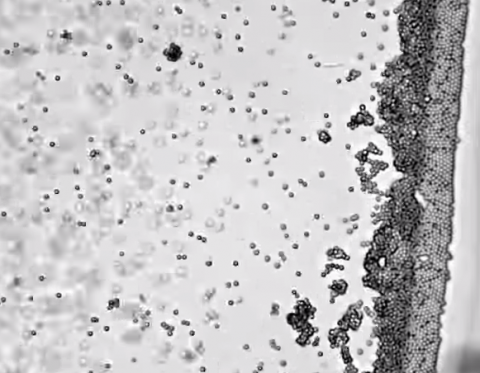
The Soft Matter Group in the School of Physics at Georgia Tech is at the interface between colloidal physics, nano-science, granular materials, and hydrodynamics. We combine experiments at different length scales and theory to explore a range of scientifically and technologically relevant topics such as the intimate mechanisms of the dynamics of fluid interfaces from the macroscopic down to the molecular level, the physics of liquid crystal materials in curved spaces, soft particles in complex fuilds, and self-assembly under confinement. The Soft Matter Group at Georgia Tech has a strong focus in basic science, which is constantly coupled with technological challenges including the development of new instrumentation and new nano- and micro-fabrication methods.
| Name | Research Interests | Research Website |
|---|---|---|
| Sven Behrens |
Soft condensed matter, especially interfacial phenomena in colloidal suspensions, emulsions, and foams |
|
| Patrick Chen | ||
| Jennifer Curtis | Cell biophysics. Cell mechanics of adhesion, migration and dynamics. Immunophysics and immunoengineering. Hyaluronan glycobiology. Hyaluronan... | Curtis Lab Website |
| Daniel Goldman |
The dynamics of individual and collectives of of organisms and robots on and within complex materials. Goldman's research program broadly... |
Goldman Lab Website (contains up-to-date info on publications, news, CV, etc) |
| Itamar Kolvin | Our research group experiments with soft condensed matter out-of-equilibrium: active matter, hydrodynamics, elasticity and fracture. To probe... | |
| Elisabetta Matsumoto |
Soft Condensed Matter Physics; Geometry of Materials; Applied Mathematics; Materials Engineering; Nonlinear Elasticity |
Matsumoto's Group |
| Claudia Nardone |
Experimental condensed matter physics, charge transfer in oxide semiconductors |
|
| D. Zeb Rocklin | I have a broad range of interests in soft condensed matter physics and adjacent fields like statistical physics, physics of living systems and hard... | |
| Simon Sponberg |
Neuromechancis, Locomotor Control, Multiscale Physics of Muscle, Maneuverability, Computational Neuroscience For publications please refer to the... |
Sponberg Lab Website |
| Peter Yunker | Nonequilibrium systems, densely packed active matter with life and death events, microbial physics, structural mechanics, fracture mechanics,... | Yunker Lab - Soft Matter of Life and Death |


